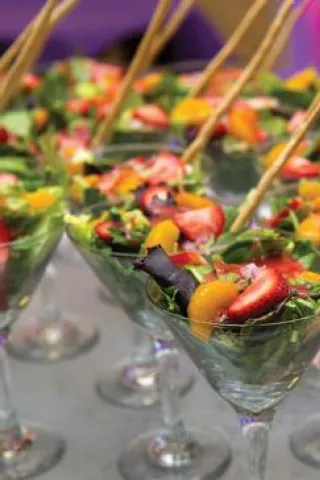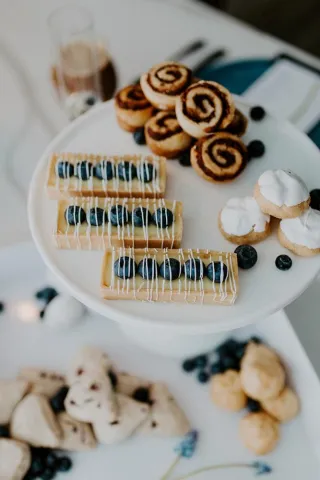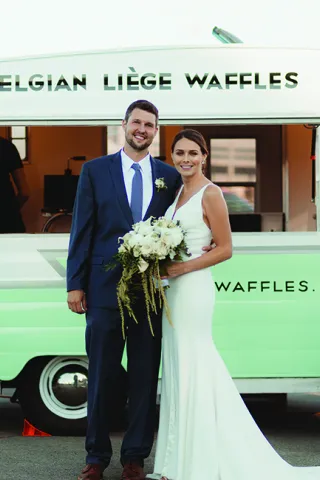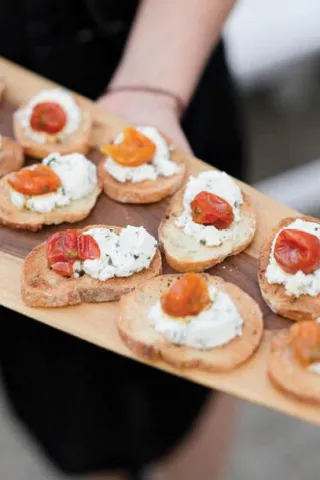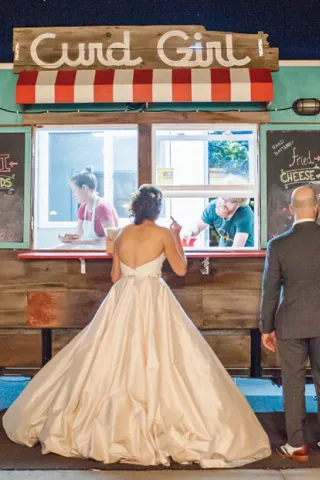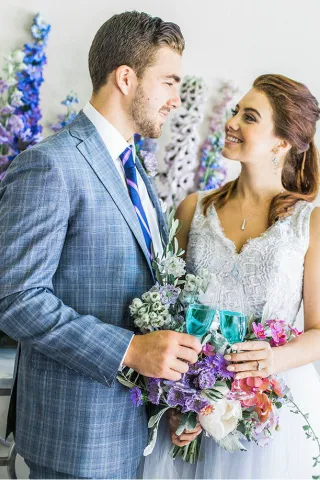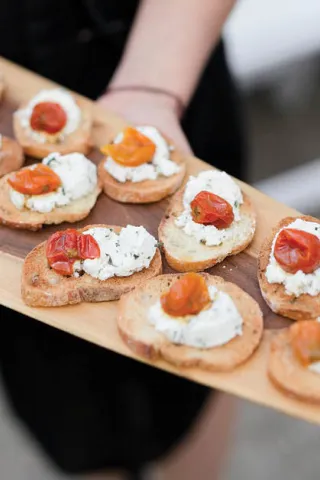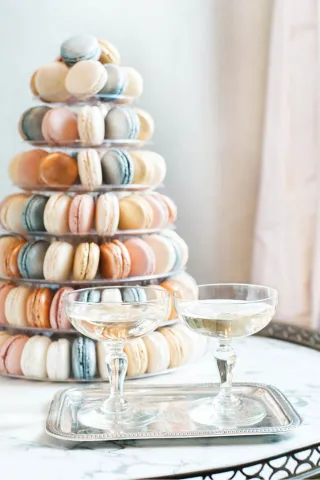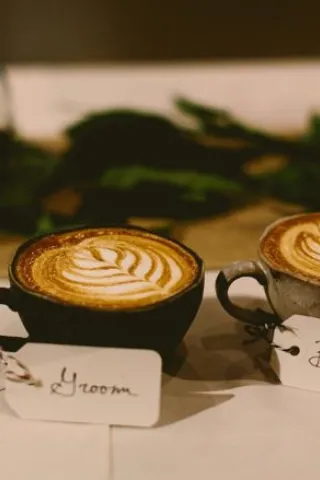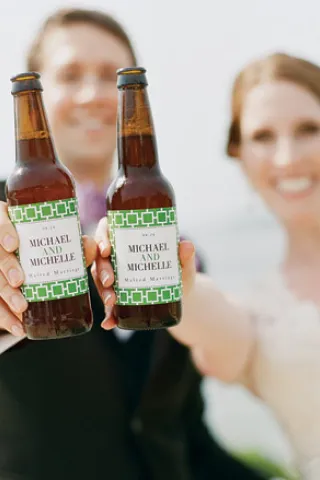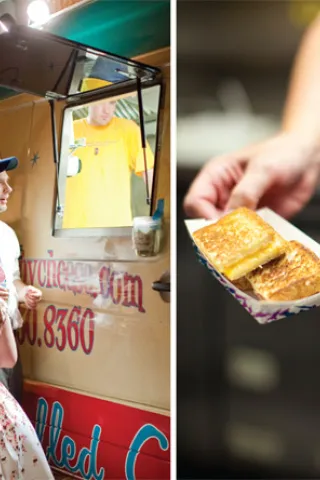Weddings unite hearts and family heritage, shared and solo life experiences. So why not demonstrate this union in the foods you choose for your first matrimonial meal?
Adam Griffin and Swathi Gandhavadi used two caterers—Bartolotta Catering and India House restaurant—when they married in Milwaukee on September 4, 2010. “We wanted our wedding to truly represent us, both as individuals and as a couple,” explains Gandhavadi, a Brookfield native. “We envisioned a romantic yet chic event that combined our distinct backgrounds and contemporary points of view, while maintaining our cultural identities.
“My Indian heritage has always been a huge part of my life,” Gandhavadi continues, “And when I met Adam [a native of Michigan], he had already fallen in love with Indian food after eating at countless buffets when he studied abroad in London.”
Their daylong celebration began at the Pilot House of Discovery World with a buffet of pastries, bagels and other breakfast staples before they were married in a traditional Hindu wedding ceremony. Guests who expected the standard sandwiches and pasta salad afterward were in for a surprise: Bartolotta whipped up a three-course luncheon of freshly baked bread, potato leek soup, eggplant rigatoni with fresh mozzarella, and apple crisp with vanilla ice cream. The menu conformed to Hindu standards, which allow for only vegetarian food and non-alcoholic drinks at the ceremony site.
Later, roughly 275 guests arrived at 1451 Renaissance Place, a renovated church, for the evening reception and dinner, another opportunity “to meld our cultures together,” Gandhavadi says. Served with cocktails were bruschetta, samosas and pakoras—the latter two savory, aromatic Indian appetizers (veggie-stuffed dumplings and veggie fritters, respectively).
Then India House presented a feast of traditional dishes—such as dal banjara, paneer tikka masala, bhindi masala and vegetable dum biryani—served family-style, with naan bread and condiments of tamarind and mint chutneys. The Griffins hired India House staff to assist waiters, so “they knew what they were serving and how it should be served.”
Dessert featured several choices, including a chocolate fountain, cheesecakes, a wedding cake with chocolate chip filling and a vegan chocolate groom’s cake (a treat for those Hindu guests who don’t eat eggs).
“We viewed our wedding day as a great opportunity to introduce our guests to dishes they may have never had before,” says the bride. “Both Indian and non-Indian guests raved about our food choices.”
Toast your heritage
Slipping international fare into one or more food stations is the easiest way to include ethnic favorites, says Katie Hoffman of Saz’s Catering in Milwaukee, which offers several German options: schnitzel with veal or chicken, pork shank, game hens or sausages from bratwurst to knockwurst.
A sausage selection might invoke images of a more casual reception, but that’s not always the case. Maria Bartolotta of Bartolotta’s Catering describes two-bite sausages with kraut in tiny buns, served butler-style, as “elegant appetizers, a different style of canapé—and classic Wisconsin.”
The mood accompanying the food “really depends upon the taste of the bride and groom,” says Hoffman, and international choices sometimes have nothing to do with heritage.
Included in Saz’s catering menu are European specialty food stations, Jamaican grilled mahi-mahi with sweet potato and plantain hash, a Szechuan chicken cashew stir-fry with Thai jasmine rice, and myriad other possibilities.
“We’ve had tropical themes, based on where a couple was moving or where they met,” Hoffman says. When a destination wedding precedes a reception back home for the guests who couldn’t attend, the menu can gives a taste of the ceremony’s international flavor.
Consider the couple who rents a castle in Ireland for their exchange of vows; Irish flair during their reception back in Wisconsin could include Irish beer tastings as well as corned beef.
“We’re able to take a couple’s stories and incorporate them into appetizers to desserts,” Bartolotta says. “A lot of work goes into the research of what spices and other ingredients are appropriate.” Her own Italian-German lineage sometimes comes into play, as does the culinary diversity of chefs at Bartolotta’s numerous restaurant and catering venues.
Communication is key
The more diverse an ethnic menu, the more wide-ranging the possibilities—and challenges for the caterer or restaurant, whose chefs may need outside assistance. “If you approach a Japanese restaurant about a wedding meal, they probably won’t be able to make French food too,” Bartolotta notes.
Rick Viviani of Viviani’s Catering Service in Middleton says a good caterer will be honest about what he or she can and can’t produce authentically. “One of our brides had traveled all over the world and wanted an appetizer buffet representing 10 countries,” he recalls. “I told her what I could and couldn’t do well.”
They came up with an appetizer buffet that included German, Japanese, Indian and Italian cuisine, among others. Such diversity typically means a higher price, so it’s crucial to weigh expectations against budget. Couples also should not presume that their assumptions about any given cuisine are the same as the caterer’s.
“I’ve cooked Italian food all my life, but your expectations might be different, based upon the region of a country,” Viviani explains. “Italy’s sweet and tart sauces use basically the same ingredients, for example, and that’s why taste tests with the bride and groom can be so important.”
Family favorites
Louie Danegelis, who with wife Lisa owns Lee John’s Catering in Waukesha, welcomes the addition of longtime family recipes or food from a couple’s favorite ethnic restaurant. “We’ve had second- or third-generation families from India bring in a preferred caterer,” he says. “Another added their favorite baklava to complement some of our own desserts.”
When an ethnic restaurant is chosen to add expertise or sentimental value to a wedding menu, “we can supply the servers, dishes, equipment and whatever else is needed to make that happen,” says Jessica Buehler, event planner at Lee John’s. “The restaurant just delivers the food.”
Buehler has also gone out of her way to find, test and tweak foreign recipes, which is what happened with a Wisconsin couple who planned their wedding while working abroad. The groom was in Spain while his bride did social service work in Africa.
After a selection of Spanish tapas as appetizers, the meal moved on to African favorites like nyama choma, meat roasted in a sauce of garlic, curry, turmeric, coriander and paprika. Buehler subbed flank steak for the traditional goat meat.
The entrée arrived with pilau rice—basmati with tomatoes and onions—and a kachumbari salad of tomatoes, onions, green peppers, cilantro and lemon juice. You won’t find this combo on Lee John’s standard catering menu, “which is meant to appeal more to the masses,” Buehler says—but, as this example demonstrates, almost anything is possible.
Think outside the box
So don’t rule out Cantonese egg noodles and Singapore rice noodles, locally grown bok choy or habanero peppers. Some cuisines blend beautifully: Danegelis knows how to match queso fresco with a cilantro-friendly chimichurri sauce, which traces its roots to Argentina and Chile.
In other cases, food stations lessen the possibility of clashing flavors. Small serving plates help guests avoid selecting a mix of incompatible dishes.
Special beverages can also enliven the menu. Think ouzo with a Greek food station, sparkling sake at a buffet of Asian choices or mojitos with Cuban foods.
“Brides want to see more splash—a wow factor—in their weddings, and that certainly includes the menu,” Danegelis says. “They’re pulling out all the stops.”
Get more from Wisconsin Bride! Follow us on Twitter and Facebook.
